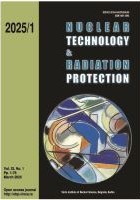
A STUDY ON THE CONVERSION COEFFICIENTS OF EQUIVALENT BLADDER DOSAGE BASED ON MONTE CARLO SIMULATION
Pages: 53-56
Authors: YanBang TangAbstract
By calculating the dose estimation coefficients for bladder phantoms with varying volumes and equivalent geometric shapes, this study offers guidance for the efficient and accurate assessment of risk organ doses 18F imaging. Based on the modeling of bladder phantoms with four different equivalent geometric shapes, and considering possible treatment conditions, the Monte Carlo method was used to simulate and calculate the absorbed doses and dose conversion coefficients of bladder phantoms of different shapes and sizes. The results show that the absorbed dose of the bladder phantom significantly decreases with the increase of bladder volume, and the absorbed dose of 70 mL is about three times that of 270 mL. The absorbed dose of the conical bladder phantom is significantly different from other shapes, with a relative deviation of 6 to 30 times that of other shapes. The ratio of bladder wall volume to surface area of the conical bladder phantom is significantly different from other shapes, with a relative deviation of 5 to 20 times that of other shapes. Therefore, when using bladder phantoms to calculate dose estimation coefficients, it is necessary to consider not only the ratio of phantom volume to surface area but also the actual shape and volume of the bladder.
Key words: positron emission tomography, Monte Carlo, nuclear medicine, radiation dosimetry
FULL PAPER IN PDF FORMAT (582 KB)
